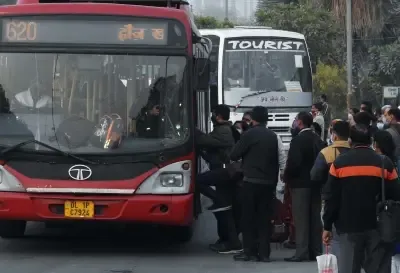CAG Report: Delhi's CNG Buses Contributing to Air Pollution

Synopsis
Key Takeaways
- CNG buses in Delhi are major air polluters.
- Emissions tests are not conducted as mandated.
- Staff shortages hinder pollution control efforts.
- Real-time pollution data is lacking.
- Old vehicles are not being scrapped effectively.
New Delhi, April 1 (NationPress) The much-anticipated CNG-powered fleet of public transport buses in Delhi is currently a significant contributor to the city's air pollution due to the government's negligence in conducting emissions tests on these buses twice a month, as highlighted in a recent CAG Report on air quality presented in the Assembly on Tuesday.
The auditor pointed out that the Delhi Transport Corporation (DTC) and other public transport buses faced insufficient checks on their emission levels, despite the National Green Tribunal's mandate for bi-weekly testing.
The report identified a shortage of staff as a critical barrier to implementing effective air pollution controls. It stated, “The Enforcement Branch of the Department of Transport lacked both adequate personnel and vehicles equipped with Pollution Under Control tools necessary for enforcing various Motor Vehicle Rules effectively,” as per the review of the government's performance under the leadership of AAP.
The Comptroller and Auditor General of India released a performance audit titled ‘Prevention and Mitigation of Vehicular Air Pollution in Delhi’, which was presented by Chief Minister Rekha Gupta in the Assembly. The audit revealed that the government lacked real-time data on pollution sources since no studies were conducted.
“Without information on the types and quantities of vehicles operating on Delhi's roads and an evaluation of their emission levels, the GNCTD could not pinpoint emissions from various vehicle categories generating substantial pollutant concentrations for developing targeted strategies,” the CAG Report noted.
Out of 6,153 Gramin-Sewa vehicles, only 3,476 underwent emission tests, and that was conducted just once from April 2019 to March 2020, instead of the required four times.
The report also criticized the slow rate of de-registering old vehicles, stating, “Only 2.98 lakh out of 47.51 lakh ‘End of Life Vehicles’ were removed from registration between 2018-19 and 2020-21. None of the 347 ‘End of Life Vehicles’ that were impounded had been scrapped by March 2021.”
Furthermore, the report indicated that the capacity of the impounding facilities was merely 4,000 vehicles, which is significantly lower than the more than 41 lakh vehicles awaiting impounding and scrapping.









